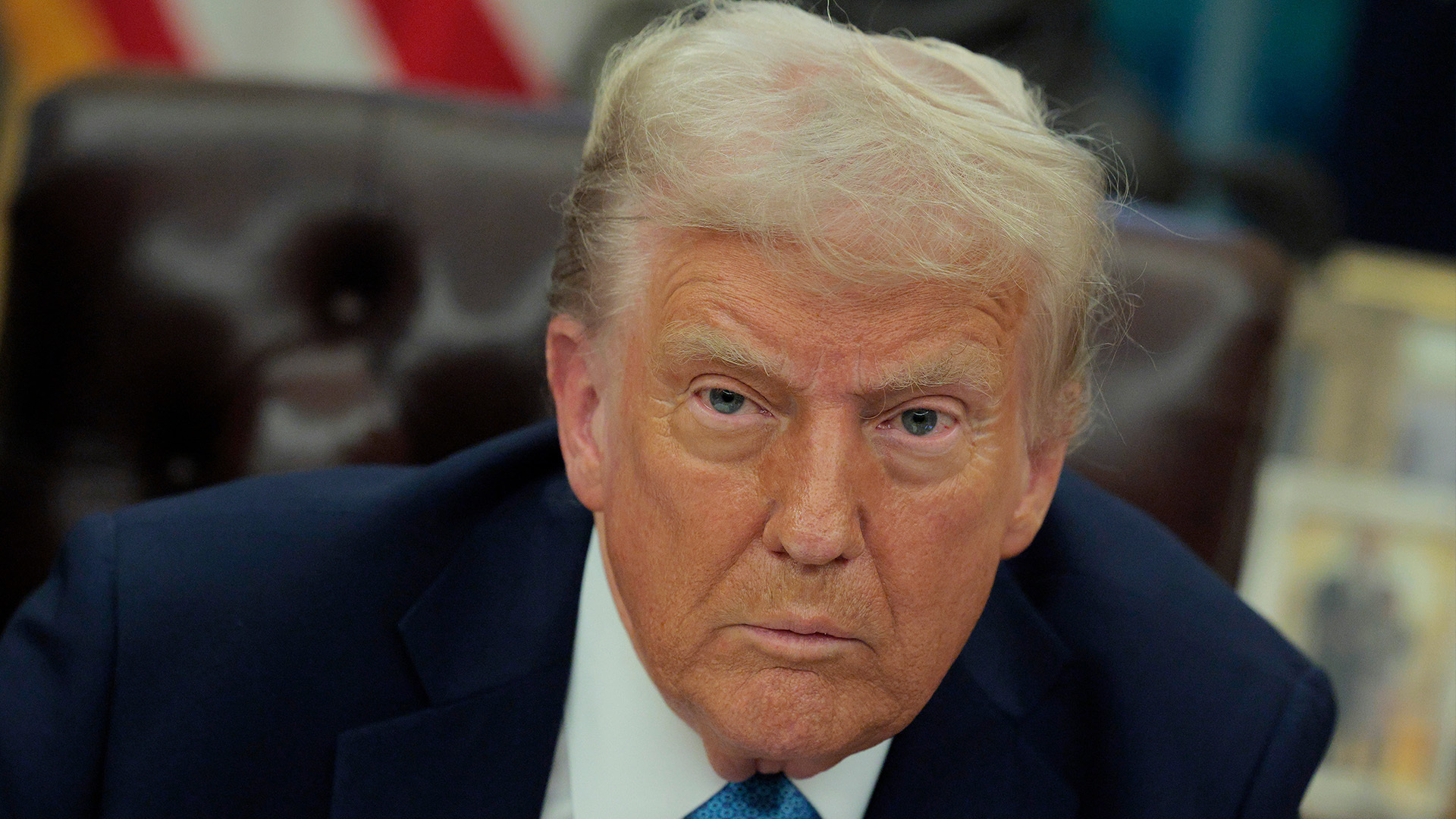
No deal for China, yet Canada and Mexico skirt Trump’s tariffs for now
By Simone Del Rosario (Business Correspondent), Emma Stoltzfus (Video Editor), Oly Noneza (Motion Graphics Designer)
- President Donald Trump delays implementing 25% tariffs on Mexican and Canadian products for one month while negotiating with both countries. China, however, still faces a 10% tariff over fentanyl trafficking.
- China condemned the tariffs and plans to file a lawsuit with the World Trade Organization.
- Trump said tariffs may cause Americans some pain, but the price is necessary to “Make America Great Again.”
President Donald Trump is in dealmaking mode regarding his new tariffs. Hours before implementing 25% tariffs on Mexican and Canadian products, Trump pressed pause for both countries. But China, facing a 10% levy starting Tuesday, Feb. 4, appears to have been left out of the last-minute deals.
Media Landscape
See how news outlets across the political spectrum are covering this story. Learn moreBias Distribution
Untracked Bias
On Monday, Jan. 3, Trump announced a one-month pause on implementing tariffs on Mexico’s products after Mexican President Claudia Sheinbaum committed to sending 10,000 service members to patrol the U.S.-Mexico border.

Download the SAN app today to stay up-to-date with Unbiased. Straight Facts™.
Point phone camera here
Canada’s concessions came after multiple calls between Prime Minister Justin Trudeau and Trump on Monday. Trump said he would pause tariffs on Canada for 30 days as Canada implements a $1.3 billion border plan and appoints a fentanyl czar.
“I don’t think we’re seeing anything like that between the U.S. president and the Chinese president,” said Mary Lovely, senior fellow at the Peterson Institute for International Economics. “And so I think the case would be made that the Chinese are simply not making the same quote-unquote deal that the Mexicans are. And that will be the distinction.”
China threatens ‘countermeasures’ and lawsuit
Trump announced Saturday, Feb. 1, that he is slapping 10% tariffs on Chinese goods over fentanyl trafficking. A spokesperson for the Chinese Foreign Ministry said the fentanyl issue is a pretext.
“China firmly deplores and opposes this move and will take necessary countermeasures to defend its legitimate rights and interests,” the Chinese Foreign Ministry said.
“We’re seeing whether this type of threat actually works to get more international cooperation,” Lovely said. “Many diplomats will tell you that’s actually not the right way to get people to cooperate with you, but we’re going to see some action.”
Meanwhile, in a statement translated into English, China’s Ministry of Commerce said, “The unilateral imposition of tariffs by the United States seriously violates the rules of the World Trade Organization … China will file a lawsuit with the WTO.”
Are the China tariffs legal?
Lovely said Section 301 of the Trade Act of 1974 gives Trump a clearer path for tariffs on China, but only by U.S. standards.
“All of this is probably going to be found not consistent with WTO rules,” she said. “Even the 301 tariffs last time were found to not be consistent with WTO rules, as many people expected. China’s retaliation was also found to be inconsistent with WTO rules. So again, none of this is happening by the book, so to speak.”
Given that, though, the WTO threat lacks teeth since both countries have been in violation before.
Get up to speed on the stories leading the day every weekday morning. Sign up for the newsletter today!
Learn more about our emails. Unsubscribe anytime.
By entering your email, you agree to the Terms & Conditions and acknowledge the Privacy Policy.
With two countries paused, what happens now?
“President Trump has a history of having lots of reasons to like tariffs. He doesn’t necessarily stay to one,” Lovely said. “We, in some sense, are thinking about this as the first wave. There will be more, perhaps. He did, on the campaign trail, promise tariffs of up to 60% on China. So certainly, the 10% could be seen as a down payment on that.”
“On the other hand, I think his team will learn by the reaction to the tariffs and to today’s announcement to suspend the tariffs. And we may see a moderation in that love of tariffs as we move forward,” she added.
“Anybody that’s against tariffs … is controlled by China,” Trump said in a Truth Social post Sunday, Feb. 2.
In a separate post, Trump added, “WILL THERE BE SOME PAIN? YES, MAYBE (AND MAYBE NOT!). BUT WE WILL MAKE AMERICA GREAT AGAIN, AND IT WILL ALL BE WORTH THE PRICE THAT MUST BE PAID.”
Also on Sunday, Trump told reporters tariffs on the European Union would “definitely happen.”
Simone Del Rosario: President Donald Trump is in deal-making mode when it comes to his new tariffs. Hours ahead of implementing 25% tariffs on Mexican and Canadian products, Trump is pressing pause for both countries.
The president says he is delaying tariffs for one month while working with Mexico and Canada.
But China, facing a 10% levy, appears to be left out of the conversation.
Mary Lovely: I don’t think we’re seeing anything like that between the US president and the Chinese president. And so I think the case would be made that the Chinese are simply not making the same quote unquote deal that the Mexicans are. And that will be the distinction.
Simone Del Rosario: In Mexico, the deal is that they’re sending 10,000 service members to the U.S.-Mexico border.
For China, Trump is slapping the nation with 10% tariffs over fentanyl trafficking.
A spokesperson for the Chinese Foreign Ministry says the fentanyl issue is a pretext. They say, “China firmly deplores and opposes this move and will take necessary countermeasures to defend its legitimate rights and interests.”
Mary Lovely: We’re seeing whether this type of threat actually works to get more international cooperation. Many diplomats will tell you that’s actually not the right way to get people to cooperate with you, but we’re going to see some action, at least as of today on the southern border.
Simone Del Rosario: In a translated statement from China’s Ministry of Commerce, China says, “The unilateral imposition of tariffs by the United States seriously violates the rules of the World Trade Organization … China will file a lawsuit with the WTO.”
The Peterson Institute’s Mary Lovely tells us U.S. Section 301 gives Trump a clearer path for tariffs on China, but only by U.S. standards.
Mary Lovely: All of this is probably going to be found not consistent with WTO rules. Even the 301 tariffs last time were found to not be consistent with WTO rules, as many people expected. China’s retaliation were also found to be inconsistent with WTO rules. So again, none of this is happening by the book, so to speak.
Simone Del Rosario: Given that, though, the WTO threat lacks teeth since both countries have been here before.
Mary Lovely: President Trump has a history of having lots of reasons to like tariffs. He doesn’t necessarily stay to one. We in some sense are thinking about this as the first wave. There will be more, perhaps. He did on the campaign trail promise tariffs of up to 60 % on China. So certainly the 10% could be seen as a down payment on that. On the other hand, think his team will learn by the reaction to the tariffs and to today’s announcement to suspend the tariffs. And we may see a moderation in that love of tariffs as we move forward.
Simone Del Rosario: Trump said Sunday, “Anybody that’s against tariffs … is controlled by China.”
WILL THERE BE SOME PAIN? YES, MAYBE (AND MAYBE NOT!). BUT WE WILL MAKE AMERICA GREAT AGAIN, AND IT WILL ALL BE WORTH THE PRICE THAT MUST BE PAID.
I’m SDR for SAN. The news on tariffs is changing by the hour. Download the Straight Arrow News app and enable notifications so you don’t miss any critical updates.
Media Landscape
See how news outlets across the political spectrum are covering this story. Learn moreBias Distribution
Untracked Bias
Straight to your inbox.
By entering your email, you agree to the Terms & Conditions and acknowledge the Privacy Policy.
MOST POPULAR
-
 Getty Images
Getty Images
Trump preparing to sign executive order to begin closing Department of Education
Read7 hrs ago -
 Getty Images
Getty Images
Trump to revoke legal status for 240,000 Ukrainians as deportations rise: Report
Read9 hrs ago -
 U.S. Department of Energy
U.S. Department of Energy
Alaska’s $44B natural gas pipeline project attracts foreign interest
Watch 1:3910 hrs ago -
 Getty Images
Getty Images
Trump admin seeking to sell nearly 450 vacant, underused federal spaces
Watch 3:00Yesterday




